Response of Runoff Yield to Land Use Changes in the Small Watershed of Core Area for 2022 Winter Olympic Games in Zhangjiakou City Based on SWAT Model
Abstract
:1. Introduction
2. Materials and Methods
2.1. Study Area
2.2. Data
2.2.1. DEM and Sub-Basin Division
2.2.2. Land Use Map
2.2.3. Soil Data
2.2.4. Meteorological and Hydrological Data
2.3. Methodology
3. Results
3.1. Calibration and Validation Results of SWAT Model
3.2. The Response of Runoff Yield to Land Use Changes
4. Discussion
5. Conclusions
- (1)
- According to the calibration and validation results at the upstream, midstream, and downstream (outlet) points (R2 > 0.80, NSE > 0.62), the established SWAT model presented stable and reliable performance and was applicable to the studied small watershed.
- (2)
- The large-scale Olympic constructions in the studied small watershed brought only −5.1% of the statistically insignificant changes in runoff yield (p = 0.87 > 0.05) and therefore coordinated the relationship between protection and development from the perspective of water resources.
- (3)
- By adding two extreme land use change scenarios, the neutralization effects of the land use changes from grassland to forest (with strong water conservation capacity) and residential and bare land (with poor water conservation capacity) demonstrated the main reason for the insignificant runoff yield change.
- (4)
- For the study area, two runoff yield change coefficients corresponding to the land use changes from shrub land to forest land and barren land were obtained as a_FRST = −8.1116 × 104 m3/km2, b_BARR = 6.5321 × 104 m3/km2.
Author Contributions
Funding
Data Availability Statement
Conflicts of Interest
References
- Eugenio, F.; Roberto, P. Forest and water: The value of native temperate forests in supplying water for human consumption: A comment. Ecol. Econ. 2008, 67, 153–156. [Google Scholar]
- Liu, S.R.; Sun, P.S.; Wen, Y.G. Comparative analysis of hydrological functions of major forest ecosystems in China. Chin. J. Plant Ecol. 2003, 27, 16–22. (In Chinese) [Google Scholar]
- Riwaz, K.A.; Mohanasundaram, S.; Sangam, S. Impacts of land-use changes on the groundwater recharge in the Ho Chi Minh City, Vietnam. Environ. Res. 2020, 185, 109440. [Google Scholar]
- Coulthard, T.J.; Macklin, M.G. How sensitive are river systems to climate and land-use changes? A model-based evaluation. J. Quat. Sci. 2001, 16, 347–351. [Google Scholar] [CrossRef]
- Gebremicael, T.G.; Mohamed, Y.A.; Betrie, G.D.; van der Zaag, P.; Teferi, E. Trend Analysis of runoff and sediment fluxes in the Upper Blue Nile Basin: A combined analysis of statistical tests, physically-based models and landuse maps. J. Hydrol. 2013, 482, 57–68. [Google Scholar] [CrossRef]
- Sajikumar, N.; Remya, R.S. Impact of land cover and land use change on runoff characteristics. J. Environ. Manag. 2015, 161, 460–468. [Google Scholar] [CrossRef]
- Wang, Y.N.; Wang, X.J.; Gao, X.W.; Li, Z.F. Canopy precipitation redistribution of typical forest vegetation in Baichazigou Watershed, Daqing Mountains of Inner Mongolia. J. Inn. Mong. For. Sci. Technol. 2017, 43, 6–9. (In Chinese) [Google Scholar]
- Geofrey, G.; Bernd, D.; Kristian, N.; Constanze, L.; Roderick, L.; Jackson, G.M.; Joy, A.O. Impact of climate and land use/land cover change on the water resources of a tropical inland valley catchment in Uganda, East Africa. Climate 2020, 8, 83. [Google Scholar]
- Lu, S.W.; Mao, F.L.; Ji, F.; Yu, X.X.; Rao, L.Y. The water resource conservation of forest ecosystem in China. Res. Soil Water Conserv. 2005, 12, 223–226. (In Chinese) [Google Scholar]
- Mou, L.T.; Philip, W.G.; Yang, X.Y.; James, H. A review of SWAT applications, performance and future needs for simulation of hydro-climatic extremes. Adv. Water Resour. 2020, 143, 103662. [Google Scholar]
- Yuan, L.; Sinshaw, T.; Forshay, K.J. Review of watershed-scale water quality and nonpoint source pollution models. Geosciences 2020, 10, 25. [Google Scholar] [CrossRef] [PubMed] [Green Version]
- Maria, R.F.; Francisca, C.A.; Maria, J.M.; Rui, R.; Maria, T.F. Long-term human-generated alterations of Tagus River: Effects of hydrological regulation and land-use changes in distinct river zones. Catena 2020, 188, 104466. [Google Scholar]
- Meng, X.Y.; Ji, X.N.; Liu, Z.H. Energy balance-based SWAT model to simulate the mountain snowmelt and runoff—Taking the application in Juntanghu Watershed (China) as an example. J. Mt. Sci. Engl. 2015, 12, 368–381. [Google Scholar] [CrossRef]
- Wang, M.Y.; Xie, H.W.; Zhao, J.; Wu, Y.P. The runoff simulation of the Yellow River Source Basin based on the SWAT model. J. Qinghai Univ. 2019, 37, 39–46. (In Chinese) [Google Scholar]
- Mo, C.; Zhang, M.; Ruan, Y.; Qin, J.; Wang, Y.; Sun, G.; Xing, Z. Accuracy analysis of IMERG satellite rainfall data and its application in long-term runoff simulation. Water 2020, 12, 2177. [Google Scholar] [CrossRef]
- Sertel, E.; Imamoglu, M.Z.; Cuceloglu, G.; Erturk, A. Impacts of land cover/use changes on hydrological processes in a rapidly urbanizing mid-latitude water supply catchment. Water 2019, 11, 1075. [Google Scholar] [CrossRef] [Green Version]
- Valentina, K.; Mike, W. Advances in water resources assessment with SWAT-an overview. Hydrol. Sci. J. 2015, 60, 771–783. [Google Scholar]
- Wang, M.; Shao, Y.; Jiang, Q.; Xiao, L.; Yan, H.; Gao, X.; Wang, L.; Liu, P. Impacts of climate change and human activity on the runoff changes in the Guishui River Basin. Land 2020, 9, 291. [Google Scholar] [CrossRef]
- Hebei Water Resources Department. Evaluation of Water Resources in Hebei Province; Hebei Water Resources Department: Shijiazhuang, China, 2006. (In Chinese)
- Zhangjiakou Water Resources Survey Bureau. Hydrology and Water Resources Manual of Zhangjiakou City, Hebei Province; Zhangjiakou Water Resources Survey Bureau: Zhangjiakou, China, 1998. (In Chinese) [Google Scholar]
- Geospatial Data Cloud Site, Computer Network Information Center, Chinese Academy of Sciences. Available online: http://www.gscloud.cn/sources (accessed on 27 November 2019).
- National Tibetan Plateau Data Center. Available online: http://data.tpdc.ac.cn/zh-hans/data (accessed on 17 September 2019).
- FAO; IIASA; ISRIC; ISSCAS; JRC. Harmonized World Soil Database (Version 1.2); FAO: Rome, Italy; IIASA: Laxenburg, Austria, 2012. [Google Scholar]
- Teklay, A.; Dile, Y.T.; Setegn, S.G.; Demissie, S.S.; Asfaw, D.H. Evaluation of static and dynamic land use data for watershed hydrologic process simulation: A case study in Gummara watershed, Ethiopia. Catena 2019, 172, 65–75. [Google Scholar] [CrossRef]
- Massetti, L.; Grassi, C.; Orlandini, S.; Napoli, M. Modelling hydrological processes in agricultural areas with complex topography. Agronomy 2020, 10, 750. [Google Scholar] [CrossRef]
- Aghsaei, H.; Dinan, N.M.; Moridi, A.; Asadolahi, Z.; Delavar, M.; Fohrer, N.; Wagner, P.D. Effects of dynamic land use/land cover change on water resources and sediment yield in the Anzali wetland catchment, Gilan, Iran. Sci. Total Environ. 2020, 712, 136449. [Google Scholar] [CrossRef] [PubMed]
- Abbaspour, K.C. SWAT-CUP 2012: SWAT Calibration and Uncertainty Programs—A User Manual; EAWAG: Zurich, Switzerland, 2014. [Google Scholar]
- Jin, X.; Jin, Y.; Mao, X. Land use/cover change effects on river basin hydrological processes based on a modified soil and water assessment tool: A case study of the Heihe river basin in northwest China’s arid region. Sustainability 2019, 11, 1072. [Google Scholar] [CrossRef] [Green Version]
- Kristian, N.; Bernd, D.; Mariele, E.; Britta, H.; Stefanie, S.; Frank, T. The impact of land use/land cover change (LULCC) on water resources in a tropical catchment in Tanzania under different climate change scenarios. Sustainability 2019, 11, 7083. [Google Scholar]
- Nosetto, M.D.; Jobbagy, E.G.; Paruelo, J.M. Land-use change and water losses: The case of grassland afforestation across a soil textural gradient in central Argentina. Glob. Chang. Biol. 2005, 11, 1101–1117. [Google Scholar] [CrossRef]
- Franciane, M.S.; Rodrigo, P.O.; José, A.D. Effects of land use changes on streamflow and sediment yield in Atibaia River Basin-SP, Brazil. Water 2020, 12, 1711. [Google Scholar]
- Öztürk, M.; Copty, N.K.; Saysel, A.K. Modeling the impact of land use change on the hydrology of a rural watershed. J. Hydrol. 2013, 497, 97–109. [Google Scholar] [CrossRef]
- Woldesenbet, T.A.; Elagib, N.A.; Ribbe, L.; Heinrich, J. Hydrological responses to land use/cover changes in the source region of the Upper Blue Nile Basin, Ethiopia. Sci. Total Environ. 2017, 575, 724–741. [Google Scholar] [CrossRef]
- Githui, F.; Mutua, F.; Bauwens, W. Estimating the impacts of land-cover change on runoff using the soil and water assessment tool (SWAT): Case study of Nzoia catchment, Kenya. Hydrol. Sci. J. 2009, 54, 899–908. [Google Scholar] [CrossRef]
- Xu, Z.; Man, X.; Cai, T.; Shang, Y. How potential evapotranspiration regulates the response of canopy transpiration to soil moisture and leaf area index of the Boreal Larch Forest in China. Forests 2022, 13, 571. [Google Scholar] [CrossRef]
- Li, C.; Fang, H. Assessment of climate change impacts on the streamflow for the Mun River in the Mekong Basin, Southeast Asia: Using SWAT model. Catena 2021, 201, 105199. [Google Scholar] [CrossRef]
- Pirro, E.D.; Sallustio, L.; Castellar, J.A.C.; Sgrigna, G.; Marchetti, M.; Lasserre, B. Facing multiple environmental challenges through maximizing the co-benefits of nature-based solutions at a national scale in Italy. Forests 2022, 13, 548. [Google Scholar] [CrossRef]

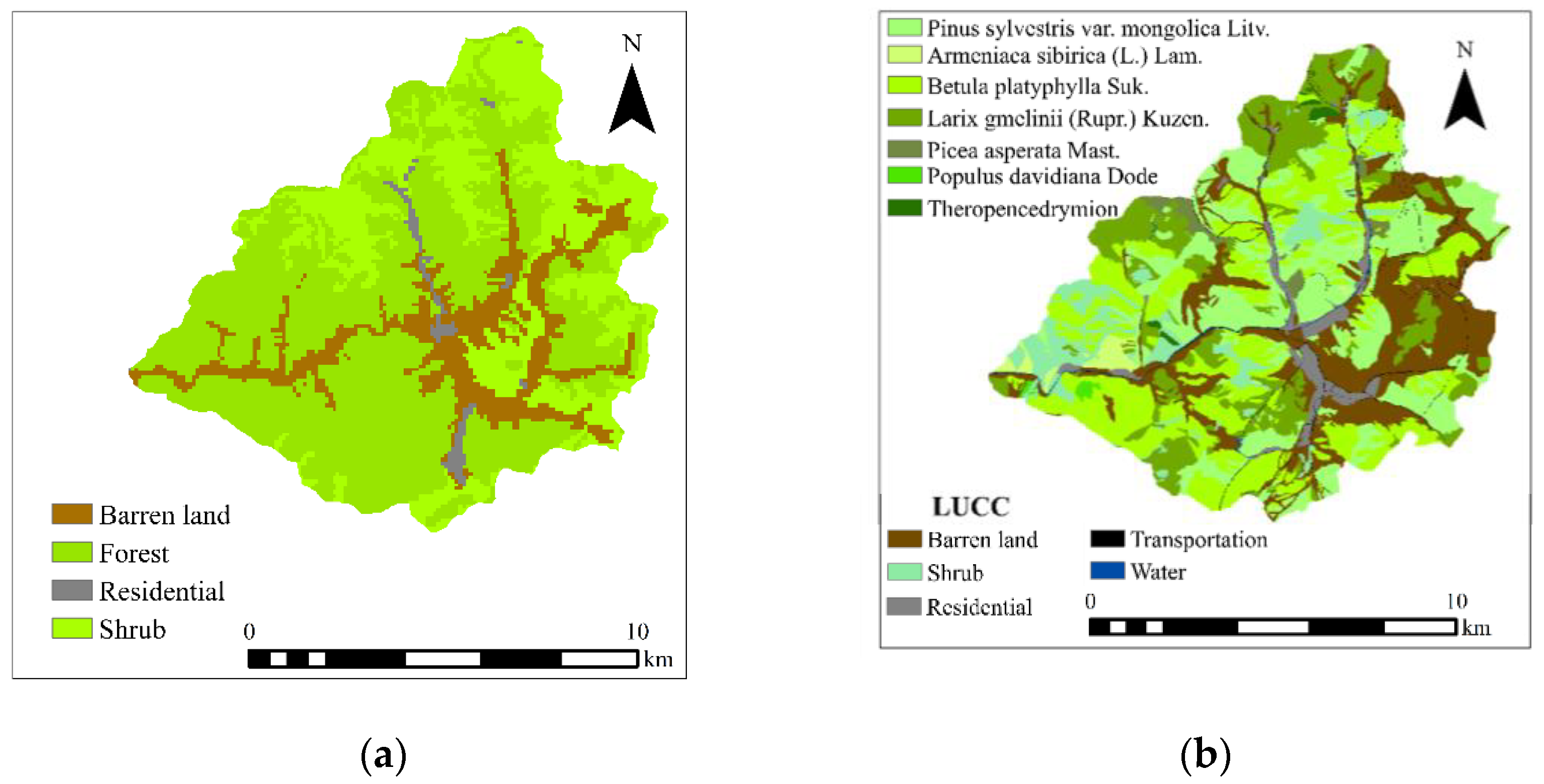

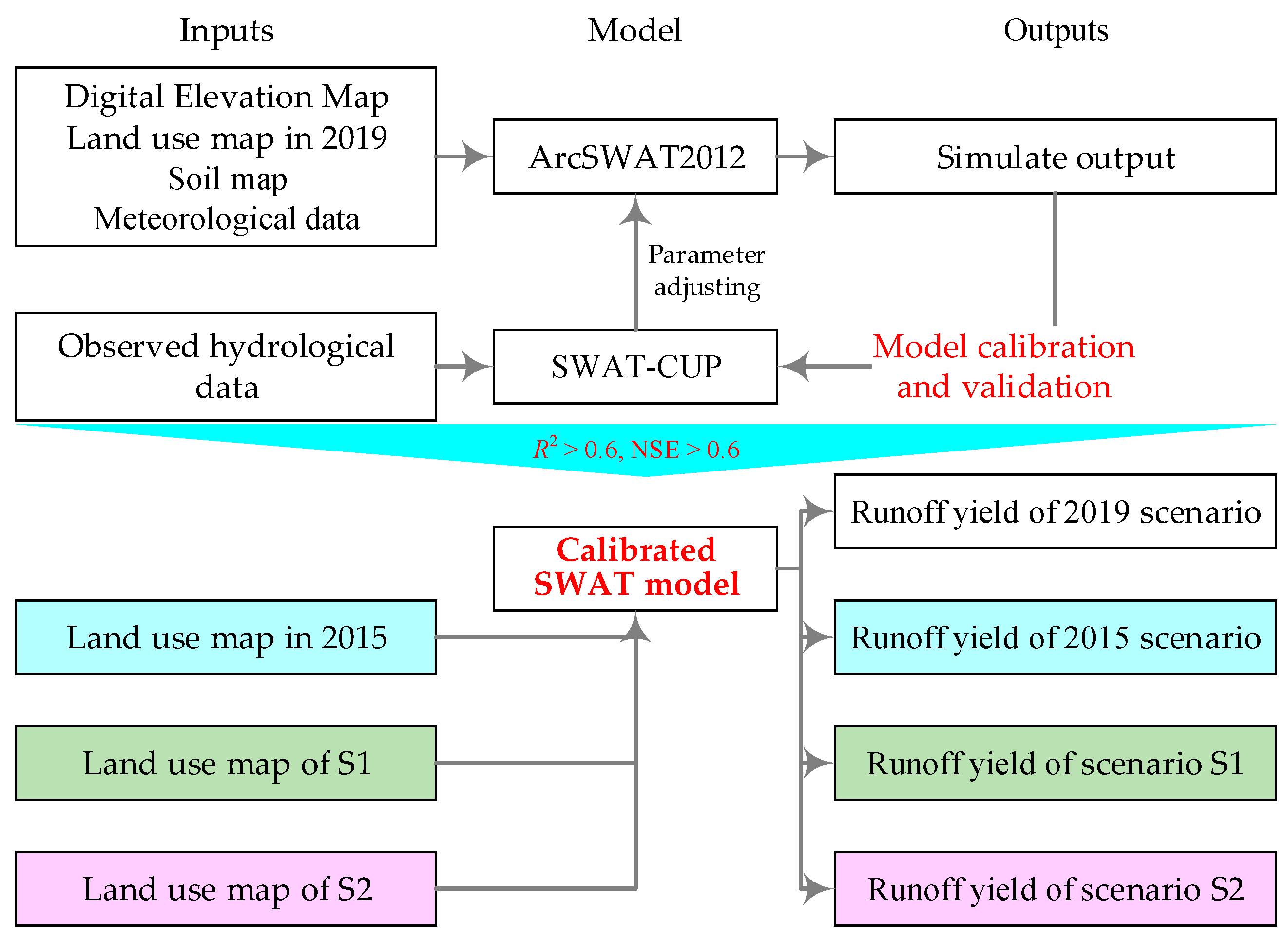
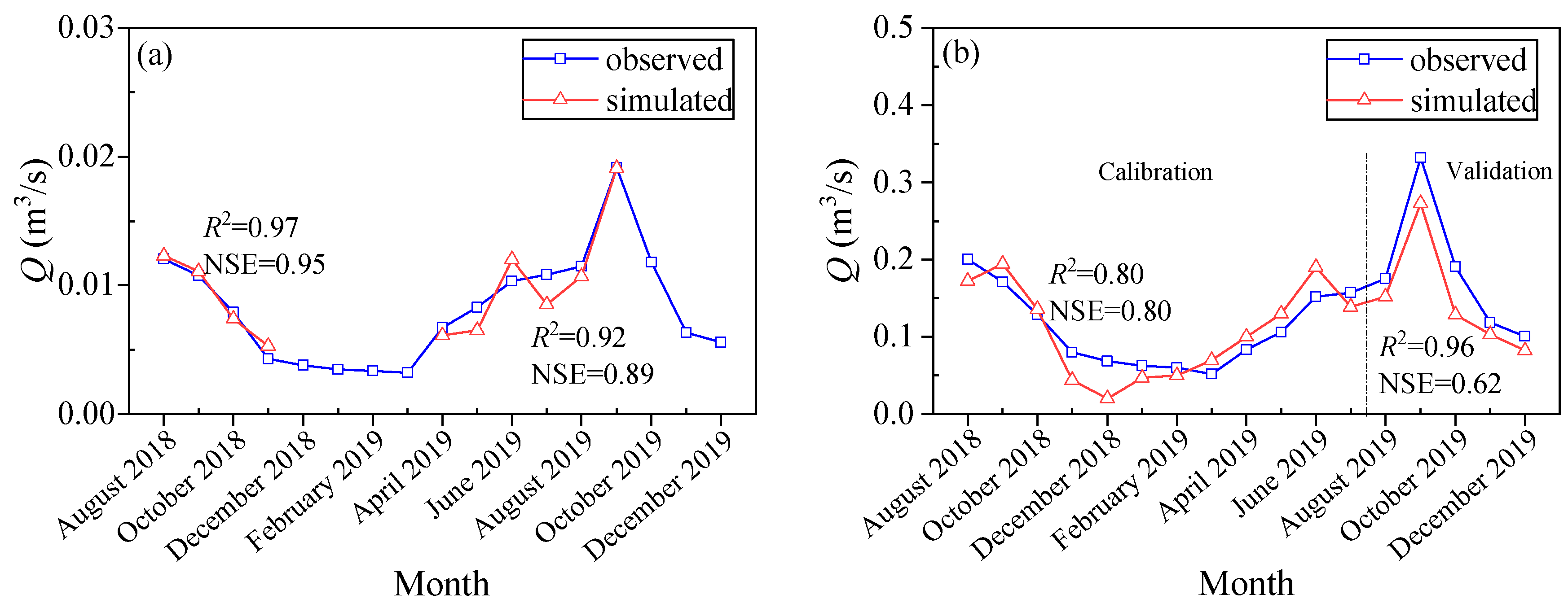
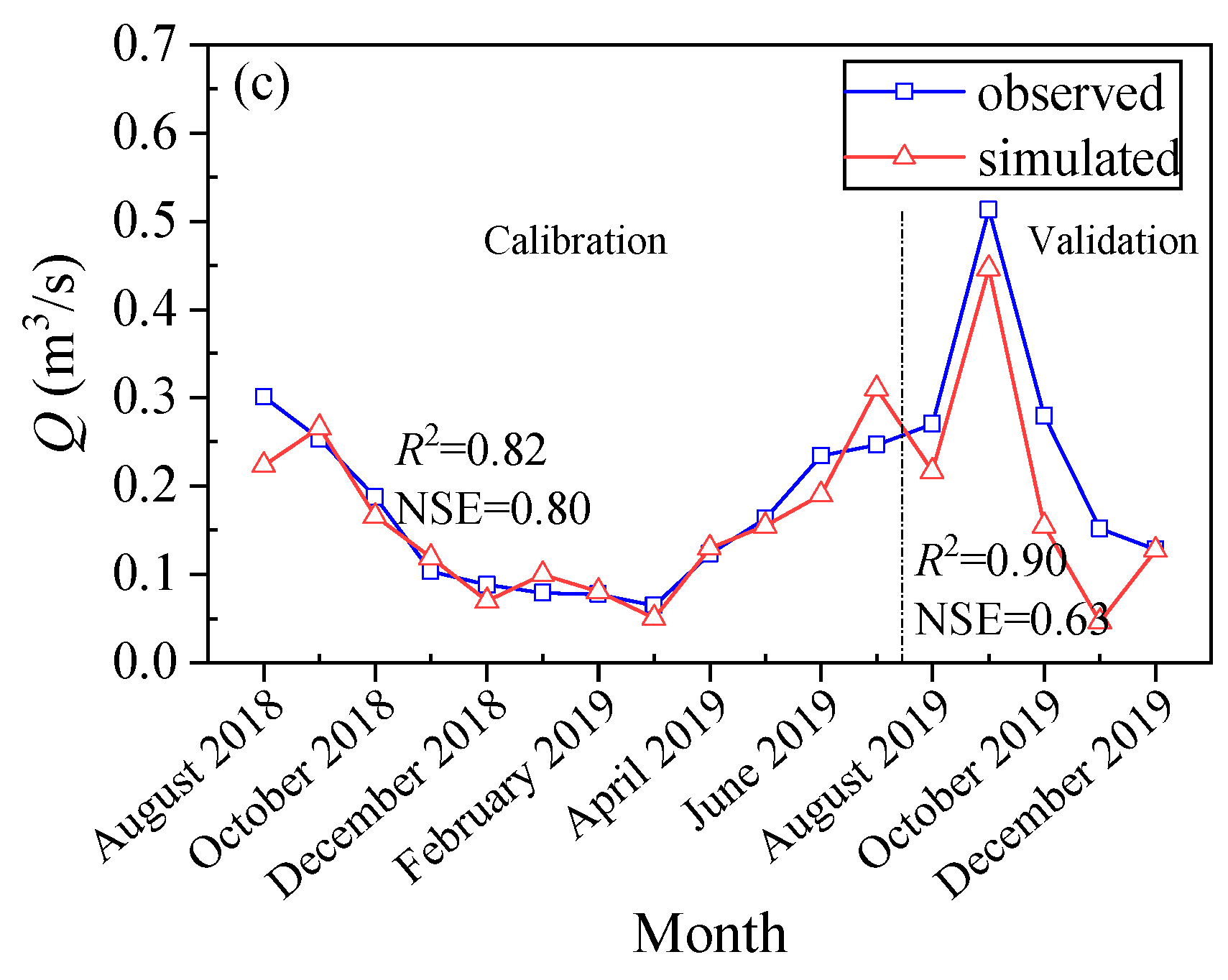
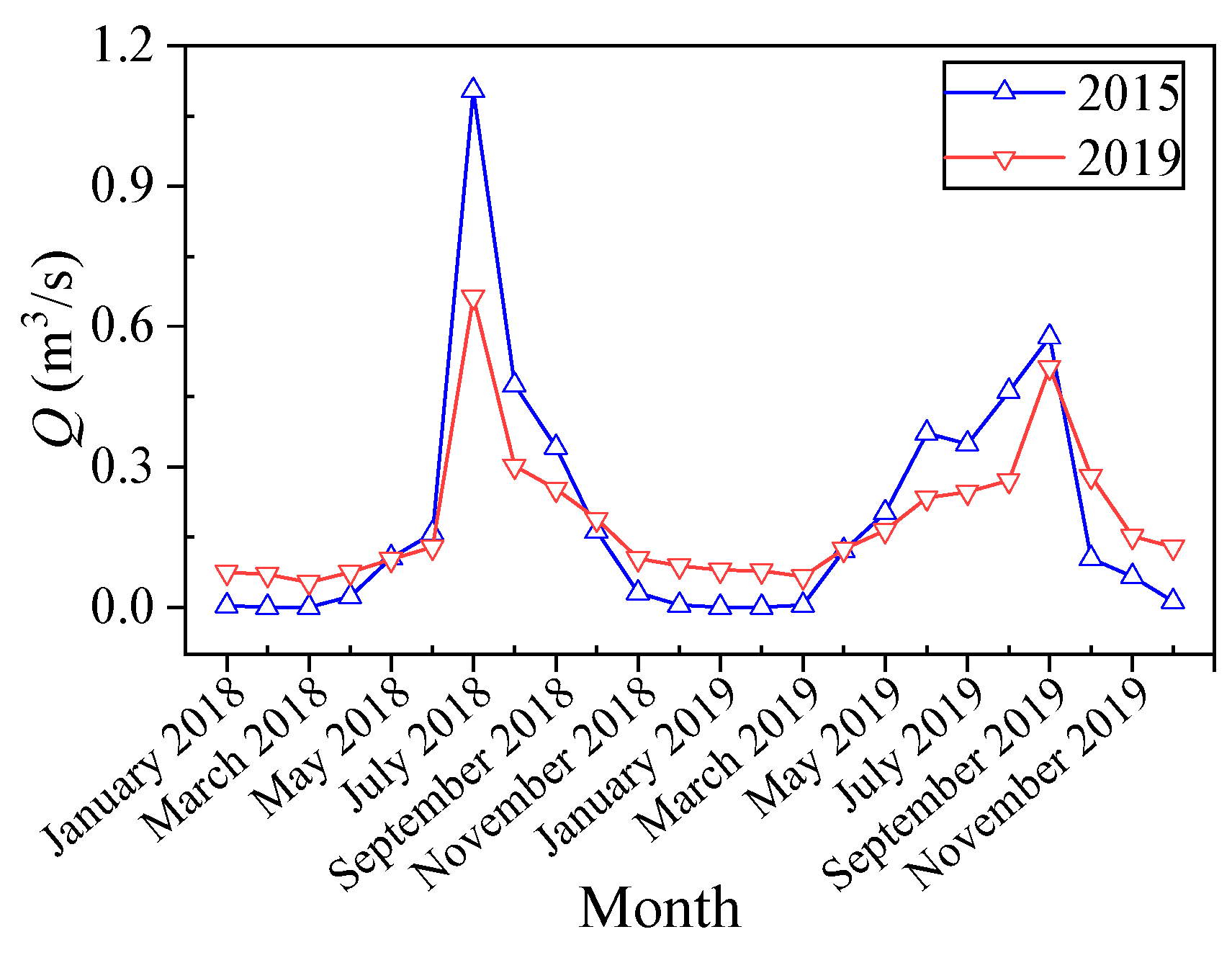

| 2015 | 2019 | |||||||
|---|---|---|---|---|---|---|---|---|
| Land Use Type | Area (km2) | %Wat. Area | Land Use Type | Area (km2) | %Wat. Area | Land Use Type | Area (km2) | %Wat. Area |
| Barren land | 16.70 | 14.17 | Barren land | 24.12 | 20.47 | Populus davidiana Dode | 0.37 | 0.31 |
| Forest | 67.25 | 57.07 | Armeniaca sibirica (L.) Lam. | 1.54 | 1.31 | Theropencedrymion | 0.52 | 0.44 |
| Shrub | 31.89 | 27.06 | Betula platyphylla Suk. | 30.56 | 25.93 | Shrub | 8.33 | 7.07 |
| Residential | 2.00 | 1.70 | Larix gmelinii (Rupr.) Kuzen. | 19.16 | 16.26 | Residential | 3.92 | 3.33 |
| Picea asperata Mast. | 1.64 | 1.39 | Transportation | 1.23 | 1.04 | |||
| Pinus sylvestris var. mongolica Litv. | 25.99 | 22.06 | Water | 0.46 | 0.39 | |||
| No. | Longitude (°) | Latitude (°) | Altitude (m) | Source |
|---|---|---|---|---|
| 1 | 115.28125 | 40.78125 | 1557 | CMADS |
| 2 | 115.53125 | 40.78125 | 1171 | CMADS |
| 3 | 115.28125 | 41.03125 | 1514 | CMADS |
| 4 | 115.53125 | 41.03125 | 1443 | CMADS |
| 5 | 115.28247 | 40.96167 | 1249 | Chongli District |
| Scenarios | S1 | S2 | |||
|---|---|---|---|---|---|
| Land Use Types | Area (km2) | Area Proportion (%) | Area (km2) | Area Proportion (%) | |
| Barren land | 16.70 | 14.17 | 40.26 | 34.17 | |
| Forest | 90.81 | 77.06 | 67.25 | 57.07 | |
| Shrub | 8.33 | 7.07 | 8.33 | 7.07 | |
| Residential | 2.00 | 1.70 | 2.00 | 1.70 | |
| Scenario | Average Q (m3/s) | Annual Runoff (m3) | Change Rate (%) |
|---|---|---|---|
| S1 | 0.1341 | 4.2290 × 106 | −31.12 |
| S2 | 0.2435 | 7.5497 × 106 | 25.06 |
| 2015 | 0.1947 | 6.1401 × 106 | \ |
| 2019 | 0.1848 | 5.8279 × 106 | −5.1 |
Publisher’s Note: MDPI stays neutral with regard to jurisdictional claims in published maps and institutional affiliations. |
© 2022 by the authors. Licensee MDPI, Basel, Switzerland. This article is an open access article distributed under the terms and conditions of the Creative Commons Attribution (CC BY) license (https://creativecommons.org/licenses/by/4.0/).
Share and Cite
Zhang, S.; Cao, C.; Wang, Z.; Lan, J.; Tian, W.; Li, X.; Huang, T. Response of Runoff Yield to Land Use Changes in the Small Watershed of Core Area for 2022 Winter Olympic Games in Zhangjiakou City Based on SWAT Model. Forests 2022, 13, 853. https://doi.org/10.3390/f13060853
Zhang S, Cao C, Wang Z, Lan J, Tian W, Li X, Huang T. Response of Runoff Yield to Land Use Changes in the Small Watershed of Core Area for 2022 Winter Olympic Games in Zhangjiakou City Based on SWAT Model. Forests. 2022; 13(6):853. https://doi.org/10.3390/f13060853
Chicago/Turabian StyleZhang, Shijia, Chen Cao, Zhongyu Wang, Jiazhu Lan, Wang Tian, Xiaodan Li, and Tousheng Huang. 2022. "Response of Runoff Yield to Land Use Changes in the Small Watershed of Core Area for 2022 Winter Olympic Games in Zhangjiakou City Based on SWAT Model" Forests 13, no. 6: 853. https://doi.org/10.3390/f13060853
APA StyleZhang, S., Cao, C., Wang, Z., Lan, J., Tian, W., Li, X., & Huang, T. (2022). Response of Runoff Yield to Land Use Changes in the Small Watershed of Core Area for 2022 Winter Olympic Games in Zhangjiakou City Based on SWAT Model. Forests, 13(6), 853. https://doi.org/10.3390/f13060853






